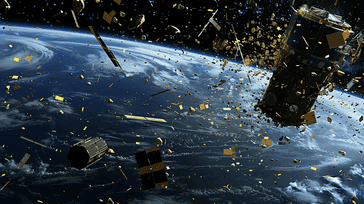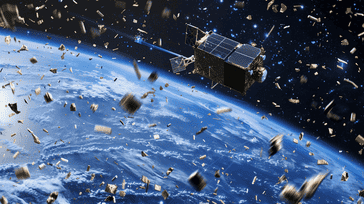
Welcome to the fascinating world of space debris management, where safeguarding Earth's orbital environment is of paramount importance. As our advancements in space exploration and satellite technology accelerate, so does the accumulation of space debris. From defunct satellites to spent rocket stages, these remnants pose a significant threat to active space missions and the integrity of our planet's orbital space. That's why the cosmic cleanup is a critical mission that requires our immediate attention and collaborative efforts.
Key Takeaways:
- Space debris management is crucial in protecting Earth's orbital environment from potential hazards.
- The accumulation of space debris poses threats to active space missions and the safety of space infrastructure.
- The cosmic cleanup is an ongoing initiative aimed at mitigating the impact of space debris.
- Advanced technology, including artificial intelligence, machine learning, and robotics, plays a vital role in space debris management.
- Space exploration and satellite technology contribute to the accumulation of space debris, but advancements in these fields also aid in debris mitigation.
Advanced Technology in Space Debris Management.
In today's era of advanced technology, the field of space debris management is undergoing a remarkable transformation. Artificial intelligence, machine learning, and robotics have emerged as powerful tools in monitoring and mitigating the ever-growing threat of space debris.
Artificial intelligence, or AI, plays a crucial role in analyzing large amounts of data to identify and track space debris. By leveraging machine learning algorithms, AI systems can accurately predict the trajectories of debris, enabling timely collision avoidance maneuvers.
Robotic technologies are also revolutionizing space debris management. Robotics and robotic arms are used for various purposes, such as capturing and removing space debris, repairing or refueling satellites, and performing maintenance tasks. These advanced robotic systems enhance efficiency and reduce the risks associated with human intervention in space.
Furthermore, innovative approaches are being adopted to tackle the challenges posed by space debris. For instance, researchers are exploring the use of swarm robotics, where multiple small robots work collaboratively to remove debris. This approach leverages the power of collective intelligence and distributed algorithms to efficiently clean up space.
"The integration of artificial intelligence, machine learning, and robotics in space debris management opens up new frontiers for ensuring the safety and sustainability of our orbital environment." - Dr. Lisa Chambers, Head of Space Debris Research at NASA
By harnessing the potential of advanced technology, space agencies and organizations across the world are making significant strides in tackling the space debris challenge. These technological advancements not only enhance our understanding of the debris population but also contribute to the development of effective mitigation strategies.
Innovative Approaches in Space Debris Management
In addition to AI, machine learning, and robotics, other innovative approaches are being explored to address space debris. These include:
- Laser-based technologies: Powerful lasers can be used to vaporize or nudge small, non-functional satellites or fragments into lower orbits, ensuring their safe disposal.
- Electrodynamic tethers: These long conductive wires can be deployed from satellites to generate electric currents that interact with the Earth's magnetic field, causing the satellite to experience drag and reenter the atmosphere.
- Active debris removal missions: Spacecraft equipped with robotic arms or nets can be sent to capture and deorbit large and potentially hazardous pieces of space debris.
These innovative approaches, combined with the power of advanced technology, hold the key to effective space debris management. As scientists and engineers continue to push the boundaries of technological advancements, we move closer to a cleaner and safer orbital environment.
Space Exploration and Satellite Technology in Debris Mitigation.

Space exploration and satellite technology play crucial roles in addressing the mounting challenge of space debris and implementing effective debris mitigation measures. As the number of space missions and satellite deployments continues to increase, so does the amount of debris in Earth's orbital environment. To safeguard our planet and maintain the sustainability of space activities, it is imperative to manage and mitigate the risks associated with space debris.
The advancements in satellite technology have greatly contributed to debris mitigation efforts. Satellites equipped with advanced sensors, imaging technology, and data analytics capabilities allow for accurate tracking and monitoring of space debris. This data provides valuable insights into the debris population, including its size, location, and trajectory, enabling scientists and engineers to develop effective strategies for debris avoidance and removal.
"Space exploration is not just about discovery; it also involves responsible space stewardship."
"Space exploration is not just about discovery; it also involves responsible space stewardship."
- Ellen Stofan, former Chief Scientist of NASA
In addition to tracking and monitoring, satellite technology is also being used to develop innovative solutions for active debris removal. Concepts such as satellite-based robotic systems and autonomous spacecraft hold significant promise in safely capturing and removing larger debris objects from orbit. These systems utilize advanced robotics and propulsion technologies to rendezvous with and capture space debris, subsequently deorbiting it to burn up in Earth's atmosphere.
The Role of Space Agencies in Debris Mitigation
Space agencies around the world are actively collaborating to address the space debris challenge. They are developing collaborative frameworks, guidelines, and best practices to promote debris mitigations efforts during space missions, satellite deployments, and spacecraft operations. This collaborative approach ensures a collective effort to minimize space debris and maintain the long-term sustainability of outer space activities.
"Space exploration is not just about discovery; it also involves responsible space stewardship."
"Space exploration is not just about discovery; it also involves responsible space stewardship."
- Ellen Stofan, former Chief Scientist of NASA
Furthermore, space agencies are investing in research and development to enhance satellite technology for more efficient debris monitoring and removal. This includes the utilization of advanced materials that mitigate satellite fragmentation, the implementation of navigation and collision avoidance systems on satellites, and the integration of artificial intelligence and machine learning algorithms to improve debris detection and prediction capabilities.
The Way Forward
Space exploration and satellite technology continue to drive advancements in debris mitigation. However, it is crucial for stakeholders across the space industry, including governments, space agencies, private companies, and international organizations, to work together and prioritize sustainable space practices. By implementing stricter regulations, incentivizing debris mitigation efforts, and fostering international collaborations, we can ensure the preservation of Earth's orbital environment for future generations and enable the continued exploration of outer space.
The Role of Data Analytics, Virtual Reality, and Cybersecurity.
In the realm of space debris management, data analytics, virtual reality (VR), and cybersecurity play crucial roles in safeguarding Earth's orbital environment. These innovative technologies offer effective solutions to track and mitigate the growing threat of space debris while protecting our space infrastructure from potential cyber threats.
Data Analytics: Tracking and Analyzing Space Debris Patterns
Data analytics plays a pivotal role in understanding and managing space debris. By analyzing vast amounts of data, scientists and engineers can track and forecast the movement of space debris, enabling accurate predictions of potential collisions with operational satellites and spacecraft. With this valuable information, proactive measures can be taken to avoid potential disasters in space.
Using sophisticated algorithms and machine learning techniques, data analytics allows us to identify patterns and trends in space debris behavior. This knowledge helps in developing more efficient debris removal strategies and optimizing the use of resources for cosmic cleanup efforts. By leveraging the power of data analytics, we can make informed decisions to minimize the impact of space debris on space missions and protect critical assets in Earth's orbit.
Virtual Reality: Simulations and Training for Space Debris Removal Missions
Virtual reality (VR) technology is revolutionizing the way we approach space debris removal missions. By creating immersive environments, VR simulations enable astronauts and engineers to practice complex maneuvers and develop efficient techniques for capturing and removing space debris. This virtual training allows them to refine their skills and ensure the success of real-world debris removal missions.
VR simulations also allow stakeholders to visualize the magnitude and complexity of the space debris problem. By immersing themselves in a virtual representation of space, decision-makers can gain a deeper understanding of the challenges involved in extracting and disposing of hazardous debris. This visualization aids in strategizing and coordinating international efforts for long-term space debris management.
Cybersecurity: Protecting Space Infrastructure
As our reliance on satellites and space-based technologies increases, so does the importance of cybersecurity in space debris management. Safeguarding our space infrastructure from cyber threats is vital to maintaining the integrity and functionality of critical systems that monitor and mitigate space debris.
Cyberattacks targeting space-based assets can disrupt communication networks, compromise data integrity, and even disable debris removal capabilities. The implementation of robust cybersecurity measures, including secure network architectures, encryption protocols, and real-time threat monitoring, is essential to secure our space infrastructure from malicious activities.
By integrating data analytics, virtual reality, and cybersecurity into space debris management strategies, we can tackle the challenges posed by space debris effectively. These technologies empower us to track, analyze, and remove debris while ensuring the safety and sustainability of Earth's orbital environment.
Conclusion.

In conclusion, space debris management is of utmost importance for safeguarding Earth's orbital environment. As our exploration of space continues and satellite technology advances, the accumulation of space debris poses a significant threat.
Through the use of advanced technology, including artificial intelligence, machine learning, and robotics, we are making significant progress in monitoring and mitigating space debris. Data analytics and virtual reality play crucial roles in tracking and analyzing debris patterns, as well as simulating space debris removal missions. Additionally, cybersecurity measures are essential for protecting our space infrastructure from potential threats.
However, the work is far from over. Ongoing efforts in space debris management are crucial to ensure a sustainable and safe environment for future space exploration. We encourage individuals and organizations to actively support and participate in initiatives aimed at the cosmic cleanup. Together, we can make a positive impact in safeguarding Earth's orbital environment for generations to come.
FAQ
What is space debris management?
Space debris management refers to the process of monitoring, tracking, and mitigating the increasing amount of human-made debris in Earth's orbital environment. It involves various techniques and technologies to minimize the risk posed by space debris to operational satellites and spacecraft.
Why is space debris management important?
Space debris management is crucial for safeguarding Earth's orbital environment. An excessive amount of space debris can pose significant risks to operational spacecraft, satellites, and even human life. By actively managing and removing space debris, we can ensure the long-term sustainability of space activities and protect critical infrastructure in space.
How does advanced technology contribute to space debris management?
Advanced technology, such as artificial intelligence, machine learning, and robotics, plays a vital role in space debris management. These technologies enable us to accurately track and predict the trajectories of space debris, identify potential collision risks, and develop efficient mitigation strategies. They also facilitate the development of innovative solutions for space debris removal.
What is the connection between space exploration, satellite technology, and debris mitigation?
Space exploration and the deployment of satellites contribute to the creation of space debris. As the number of space missions and satellite deployments increases, so does the risk of debris accumulation. However, satellite technology also plays a crucial role in debris mitigation by enabling precise tracking and monitoring of space debris and aiding in the development of mitigation strategies.
How do data analytics, virtual reality, and cybersecurity contribute to space debris management?
Data analytics helps in analyzing and interpreting large volumes of data related to space debris, allowing scientists and researchers to identify patterns, predict collision risks, and optimize mitigation efforts. Virtual reality enables simulations and training for space debris removal missions, improving preparedness and efficiency. Cybersecurity is essential in protecting space infrastructure from potential cyber threats that could compromise debris mitigation operations.







